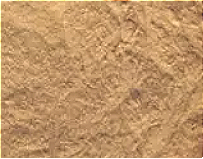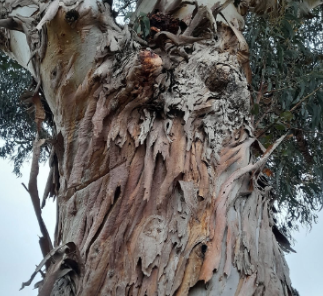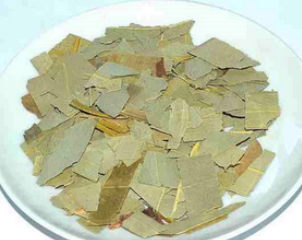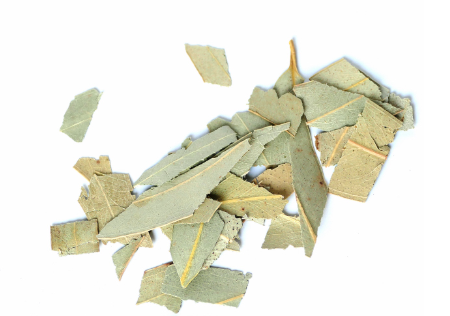Eucalyptus globulus leaf extract is the extract of the dried leaves of the Eucalyptus tree. Used by traditional medical science for a number of common ailments and now commonly available over-the-counter (OTC) in ointments, drops, mouthwashes, suffumes and balms. It is considered safe, but it must be considered that excessive doses of these preparations can pose a danger to human health.
Raw Materials and Their Functions
Eucalyptus Globulus Leaves. The leaves of the eucalyptus tree are rich in bioactive compounds, including eucalyptol (cineole), which imparts the extract's noted therapeutic properties.
Industrial Production Process of Eucalyptus Globulus Leaf Extract
- Extraction of bioactive compounds from Eucalyptus Globulus leaves. This can be done using solvents such as ethyl alcohol or water, depending on the solubility of the desired compounds.
- Purification. After extraction, the solution containing the bioactive compounds is purified to remove impurities and solvent residues.
- Quality Control. Eucalyptus Globulus leaf extract undergoes quality testing to ensure it meets the required standards in terms of purity and concentration of bioactive compounds.
It appears in the form of a brown powder

What it is for and where
Cosmetics
Skin conditioning agent. It is the mainstay of topical skin treatment as it has the function of restoring, increasing or improving skin tolerance to external factors, including melanocyte tolerance. The most important function of the conditioning agent is to prevent skin dehydration, but the subject is rather complex and involves emollients and humectants that can be added in the formulation.
Perfuming. Unlike fragrance, which can also contain slightly less pleasant or characteristic odours, the term perfume indicates only very pleasant fragrances. Used for perfumes and aromatic raw materials.
CAS 84625-32-1
EC number 283-406-2
Eucalyptus leaf studies
The Eucalyptus (Eucalyptus globulus) is a large plant that easily reaches 30 to 40 metres in height and thrives in temperate climate regions and belongs to the Myrtaceae family.

There are about 800 species of eucalyptus, including:
- Eucalyptus staigeriana
- Eucalyptus camaldulensis
- Eucalyptus pellita
- Eucalyptus regnans
- Eucalyptus grandis
- Eucalyptus urophylla
- Eucalyptus Sideroxylon
- Eucalyptus maidenii
- Eucalyptus robusta
- Eucalyptus citriodora
- Eucalyptus tereticornis
What it is used for and where

Its leaves are used to produce:
- oil that needs to be diluted (and not taken pure) against colds
- ointment to relieve muscle aches
- hot steam for cold inhaments
- mouthwashes against gingivitis and other oral tract infections
Eucalyptus is the primary food source for Koala living in Australia.
It is a primary source for the production of paper and cellulose in South America.
Studies
The most interesting ingredients, from a healthy point of view, of these plants are mainly alkaloids, flavonoids, pigments, phenolic, terpenes, amides, steroids and essential oils. Recent studies have exhibited its antimicrobial effects against bacterial, fungal, parasitic and viral agents (1).
Methanol extract (8:2) demonstrated significant anti-inflammatory activity through membrane stabilization protein denaturation inhibition, anti-lipoxygenase, and proteinase inhibition assays. (2).
Another interesting application of eucalyptus essential oil is its larvicide and insecticide potential and can therefore be used in the community in artificial water bodies as an eco-compatible vector control measure in the era of the resistance to chemical insecticides (3).
The data emerging from this study shed other health-oriented characteristics of the use of the aqueous extract of leaves of Eucalyptus globulus that can play an important role as an anti-hypertensive agent to reduce the burden of cardiovascular complications (4).

Typical commercial product characteristics
| Appearance | Colorless or faintly yellow liquid |
1,8-eucalyptus Content
| 80% |
| Melting point | 179°C |
| Density | 0.909 -- 0.919 (20°C/20°C) |
| Refraction Index | 1.4590 -- 1.4650 (20°C) |
Optical Rotation
| +3° |
| Pb | ≤0.001 ppm |
| As | 0.8mg/kg |
References___________________________________________________________________
(1) Ghasemian A, Eslami M, Hasanvand F, Bozorgi H, Al-Abodi HR. Eucalyptus camaldulensis properties for use in the eradication of infections. Comp Immunol Microbiol Infect Dis. 2019 Aug;65:234-237. doi: 10.1016/j.cimid.2019.04.007.
(2) Ashour RMS, Okba MM, Menze ET, El Gedaily RA. J Eucalyptus Sideroxylon Bark Anti-inflammatory Potential, Its UPLC-PDA-ESI-qTOF-MS Profiling, and Isolation of a New Phloroglucinol. Chromatogr Sci. 2019 Jul 1;57(6):565-574. doi: 10.1093/chromsci/bmz029.
(3) Kaura T, Mewara A, Zaman K, Sharma A, Agrawal SK, Thakur V, Garg A, Sehgal R. Utilizing larvicidal and pupicidal efficacy of Eucalyptus and neem oil against Aedes mosquito: An approach for mosquito control. Trop Parasitol. 2019 Jan-Jun;9(1):12-17. doi: 10.4103/tp.TP_35_18. Epub 2019 May 22.
Abstract. Background and objectives: Plant-based products can provide safe and biodegradable mosquito control agents. The essential oils have a strong odor due to complex secondary metabolites and exhibit lower density than that of water, which renders them suitable to form a thin layer above the water surface. The present study was designed to evaluate the larvicidal, pupicidal activity of Eucalyptus and neem oils against Aedes aegypti and Aedes albopictus....Conclusions: Eucalyptus oil was more effective against mosquito larvae at lower concentration as compared to neem oil. It can, therefore, be utilized in the community in artificial and small temporary water bodies as an eco-friendly vector control measure in the era of increasing resistance to chemical insecticides.
(4) Ajebli M, Eddouks M. Eucalyptus globulus possesses antihypertensive activity in L-NAME-induced hypertensive rats and relaxes isolated rat thoracic aorta through nitric oxide pathway. Nat Prod Res. 2019 Apr 10:1-3. doi: 10.1080/14786419.2019.1598992
Abstract. In the current study we determined the effect of the aqueous extract of leaves of Eucalyptus globulus (AEEG) in anesthetized normal and L-NAME-induced hypertensive rats and on rings of isolated thoracic aorta from Wistar rats at a dose of 160 mg/kg. Our results show that AEEG extract reduced systolic, mean and diastolic blood pressure after repeated (7 days) oral administration of this extract in hypertensive rats. In addition, it was revealed from the present study that AEEG relaxed aortic rings in a dose-dependent (25-200 µg/ml) manner via the activation of nitric oxide production. Pre-treatment of aortic rings with indomethacin, glibenclamide, nifedipine or propranolol did not attenuate the AEEG-induced vasorelaxation. Our data elucidate the health-orientated virtues of using AEEG which may play an important role as an antihypertensive agent to reduce the burden of cardiovascular complications.
![]() Eucalyptus globulus leaf extract
Eucalyptus globulus leaf extract 





